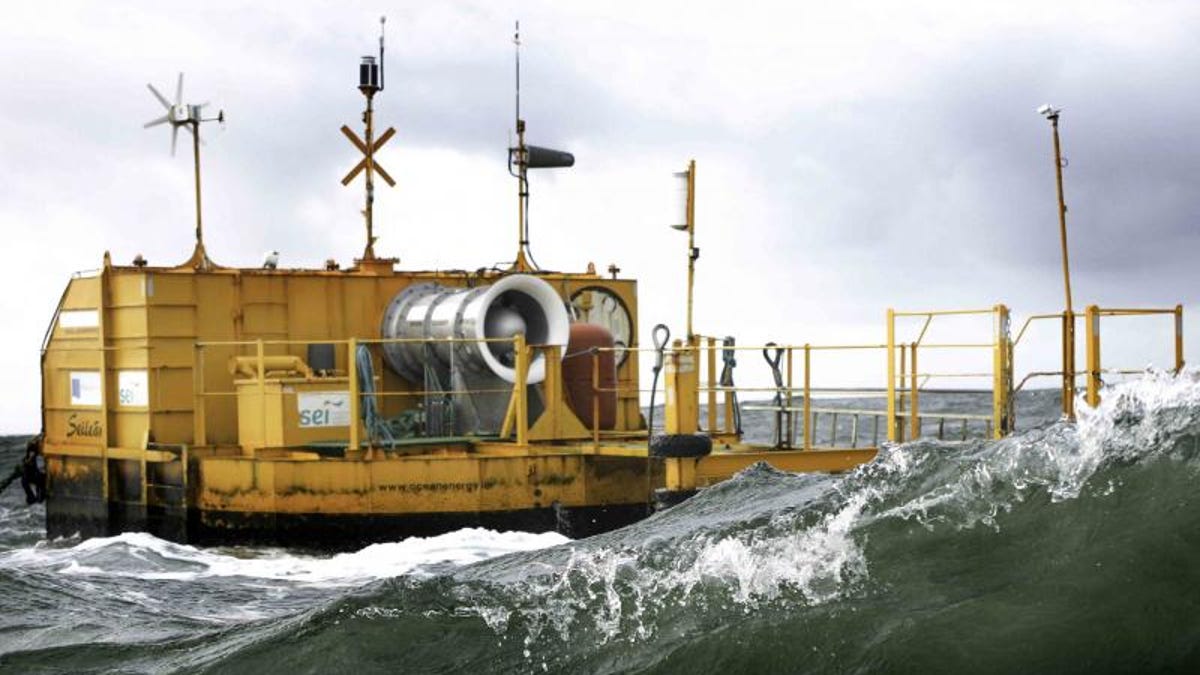Could This Be the Final Frontier for Renewable Energy?

With 70% of the Earth’s surface covered by oceans, wave power could be one of our largest energy resources. If you’ve ever been knocked off your feet by a big wave, you’ve felt a smidgeon of that power.
For decades, scientists and engineers have looked to our vast oceans and dreamed of ways to extract a tiny fraction of that energy. In an era of climate awareness and anxiety, finding ways to do that is finally getting more attention.
The Biden administration’s Ocean Climate Action Plan
reveals how the ocean holds important potential for renewable energy, both from offshore wind power and less-explored sources such as waves, tides and currents. Even the chillier waters that lie deep below tropical seas could provide clean marine energy.
The plan acknowledges an ambitious endeavor nearing completion off the coast of Oregon, where 7 miles of conduit were laid under the floor of the Pacific Ocean using pioneering horizontal drilling techniques. Soon, thick cables will be run through that conduit to connect the mainland to PacWave, an offshore experimental testbed built to develop and demonstrate new technology that converts the power of waves into onshore electricity.
Once fully operational (as soon as 2025), PacWave could generate up to 20 megawatts, enough to power a few thousand homes. “I get really excited about wave energy because the resource is so large,” Levi Kilcher, a senior scientist with the National Renewable Energy Laboratory, told me.
Kilcher is a lead author on the 2021 NREL report
that compiled available data on marine energy sources in the US, including waves, tides and ocean currents. The team found that the total energy potential is equal to more than half (57%) of the electricity generated in the US in a single year.
Though experimental sites like PacWave point to an efficient way to harvest wave power and could facilitate breakthroughs, wave energy still has a way to go before becoming a significant source of electricity. Though waves are steady, they aren’t identical, posing a key challenge in designing a machine to capture their energy.
“You’re trying to tune [the technological approach] so you can take advantage of these shifting kinds of waves,” said Andrea Copping, a senior researcher at the Pacific Northwest National Laboratory.
Differing approaches to capturing wave energy include devices that ride the top of waves or ones that translate the pressure waves put on the seafloor into power. Another approach involves devices called oscillating water columns, which compress air as waves rush through them. That compressed air spins a turbine and generates energy.
Power from the depths
Waves are just one potential source of marine energy that scientists and officials are investigating.
Copping says there’s renewed interest in another form of marine energy: ocean thermal energy conversion, or OTEC, which involves bringing up colder water from deeper parts of the ocean. This chilly flow then goes through a heat exchange process with warmer surface water, similar to the way home heat pumps exchange hot and cold air. That process drives a turbine to generate electricity.
OTEC technology was pioneered in the 1970s when energy prices soared, but it never really caught on. According to Copping, climate change has led to more attention on OTEC, which could be a fit for islands like Puerto Rico, Guam and small nations in the South Pacific.
“There’s a real interest, and we really think it’s going to go this time,” Copping said.
A small OTEC plant has been functioning in Hawaii for years. Copping believes new commitments from the US government hold promise for the future of the technology, which has also seen significant interest in Japan and other surrounding nations.
It’s possible that concern over climate change could unlock new sources of funding for OTEC. In the meantime, building smaller facilities (10 megawatts or less) and putting them on land instead of floating on the ocean is making the tech more affordable, Copping said.
There’s also the added bonus that the cold water pipes can double as a form of air conditioning in the tropical locales where OTEC works best.
Going with the flow
Much of the US coastline, like Alaska, the Pacific Northwest and the rocky shores of Maine, has climates where there’s little chance of finding surface water warm enough for OTEC. Fortunately, some of these spots are optimal for generating power from a source that relies on shallower water: tides.
Growing up in Alaska, Kilcher was always fascinated by the power of tides. But he had no idea that nearby Cook Inlet is considered one of the world’s ideal spots for harnessing their energy. When Kilcher first started work at the National Renewable Energy Laboratory, he was surprised when his colleagues informed him that this hometown of Homer, Alaska, was among the best tidal energy spots in the world.
When it comes to converting the ocean’s movements into electricity, tidal energy technology is the most developed — it’s about as simple as putting the right turbine in the right place in the water. A number of tidal-power projects have already been deployed in Europe and elsewhere, as well as in niche applications around the world.
Tidal energy is the yin to the yang of wave energy. Waves can be anywhere and everywhere, but they’re hard to predict. Tides are a mostly known quantity and are global, but their power potential is restricted to a few very specific places. The fast flows required to generate power are typically only found in narrow channels or between islands and the mainland. Still, where tidal energy works, it’s a very reliable form of renewable energy.
“One thing that makes tidal energy especially attractive is it’s 100% predictable,” Kilcher said.
Some smaller experiments are being run with other consistent characteristics of oceans besides tides, like their major, slow-moving currents. Kilcher noted that research is underway off the coast of the southeastern US to examine how much power can be pulled out of currents before impacting heat circulation patterns in the North Atlantic.
“You don’t want to be extracting so much energy that the Gulf Stream starts to shut down,” he said. “These are the kind of scientific research questions that we look at.”
Thar she blows
So far, effectively pulling power from the ocean has less to do with water than with the air above it. Offshore wind energy is by far the most productive source of power that we transfer from ocean to land.
“Offshore wind is the most mature technology without a doubt,” Bryson Robertson, director of the Pacific Marine Energy Center at Oregon State University, told me. “We’ve been working on wind energy systems really since the birth of civilization. We were running sails [on boats], and we were using windmills to grind wheat.”
Large, power-generating wind turbines anchored to the seafloor have become a familiar sight off the coast of the northeastern states and other locales. Robertson says that floating offshore wind turbines are a newer, promising technology that could help scale up the amount of electricity we literally pull out of thin air.
Wind is more consistent offshore, and floating infrastructure can be deployed in more parts of the world and on deeper seas. And taller turbines could access high-altitude winds in locations that are out of the view of the public.
Robertson believes the opportunities to generate more wind power from floating infrastructure are significant enough to make a real dent in carbon emissions.
A tough environment
Unlike developing a new mobile app or even a mobile phone, building the infrastructure to pull power from one of the most inhospitable and untamed environments on Earth can be a slow, difficult process.
“We know less about these tidal raises, these big wave areas because we stay out of them,” Copping said. “That’s one of the reasons this is taking time. But just look at the ocean — it’s hard not to see the energy potential.”
There are also a number of other considerations, including the impacts marine energy infrastructure could have on wildlife, the broader environment, local populations, fishing and other industries.
“I think the biggest issue is uncertainty,” Robertson added. “We haven’t done this at scale before, so what are the environmental impacts going to be?”
He says the policy process may be slow for good reasons, but the need for marine energy is still urgent.
“We need to find a way to deploy technology faster while being cognizant of the environment,” he said. “We just need to find a way to accelerate this process if we’re going to have a measurable impact on climate change.”
More on renewable energy
Source: CNET















